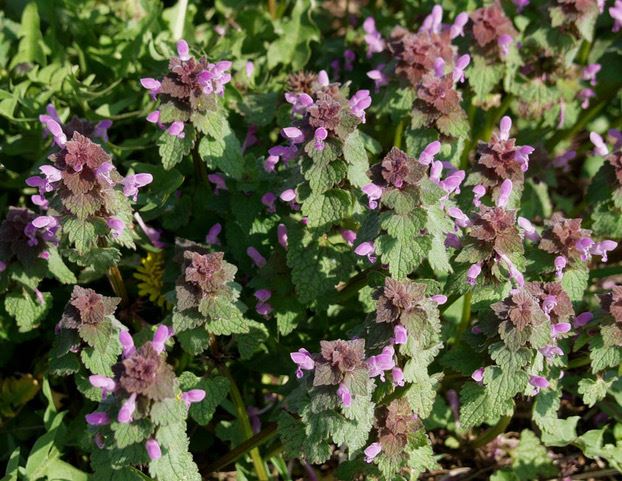
Learn more: Spring & the Wood Element
or
Register Here
It is Spring and a carpet of Purple Dead-Nettle is covering my garden. Even though I had put the vegetable garden to bed, tucking it in with straw, this "weed" decidedly took over. These Dead heads not only look like a weed, they smell like one too! Unlike the followers of a particular psychedelic rock band there is nothing distinctive about this plant that would indicate it might be edible, useful or medicinal. While I was never a Dead Head I do march to the beat of a slightly different drummer, and just because I harvest, juice and infuse what most people think of as useless weeds it doesn't mean I'm tripping or that I smell bad, but it does mean that I'm ahead of allergy season.
Introduced from Europe and listed as an invasive species in some parts of North America it can frequently be found growing alongside Henbit Dead-nettle, Lamium amplexicaule. Amplexicaule means "clasping" and refers to how the leaves grab the stem. Both have similar leaves and bright purple flowers, but the difference between the two can be seen in the leaves. Purple Dead-nettle's leaves are stalked on the flower stem compared to the un-stalked leaves of Henbit Dead-nettle.
If you were called to inspect this plant more closely you would find that it has a square stem typical of the mints but the smell would never let on that it is in the mint family. It smells more like earth and grass with the flowering tops and leaves being edible. The harvested young aerial parts can be finely chopped and used in sauces, salads or as a spring vegetable and while it may be nutritious it has no flavor of great interest. It is one of the first plants to flower in the southeast where I live and may continue flowering throughout the year even during the milder winter months providing a food source to bees (and humans!) when few other nectar sources are available.
Purple Dead-nettle has long been used in folk medicine in Europe, Asia and Africa and unlike stinging nettles (Urtica) it has no sting and is therefore considered, "dead." There is evidence of anti-inflammatory, anti-oxidant, and free radical scavenging properties comparable to that of ascorbic acid. It can be used fresh or dried and made into a tea or tincture for allergic inflammation. A natural source of flavonoids including quercetin, Purple Dead-nettle can improve immune system performance while reducing sensitivity to allergens and inhibiting inflammation. The anti-allergy properties of flavonoids come from their ability to reduce the release of histamine. Research has shown that L. purpureum is significantly anti-inflammatory with pain-reducing properties and works through inhibiting the release of prostaglandins, the principle mediator for inflammation in allergies and chronic inflammatory conditions. This is good news for allergy sufferers (see recommendations below.) The whole plant has also been used to relieve pain in rheumatism and other arthritic ailments. A rich source of antibacterial essential oils Purple Dead-nettle has a wide range of antimicrobial activity and antifungal properties, which may be useful for staph, E. coli and candida.
Never before has one weed so thoroughly taken over my garden. It definitely has my attention. Previously L. purpureum was only vaguely familiar to me, as I had seen it on my daily walks growing along the roadside. It was so far off my radar as a medicinal plant that I had trouble remembering what it was. My apprentice pointed it out to me one day on a plant walk and I felt totally incompetent asking her – what is that plant again? In my defense, it is indeed rather obscure in the herbal literature. There is still so much we don't know, but I do know that our medicine is never any further than where we are right now.
Recommendations:
No known contraindications. Purple Dead-nettle's actions have not been extensively researched and documented but may include: anti-inflammatory, astringent, diuretic, diaphoretic, antimicrobial, antifungal and purgative. Collect entire above ground, aerial parts for food and medicine. Taking Purple Dead-nettle when you suffer from allergies will help prevent secondary infections of the sinus, throat and lower respiratory tract. I am happy to report that due to the following protocol I am now allergy free!
Tincture: 1-2 ml 3x/day (1:5 in 40%)
Infusion: 1 cup boiling water over 1 heaping teaspoon dried herb and infuse covered for 10 minutes. Strain and drink as often as desired. To use as a daily tonic for chronic conditions put 1 oz. dried herb in a quart jar, or 1/3 jar filled with chopped fresh herb, fill with boiling water and cover. Let stand for 3-4 hours and drink one quart per day just prior to and at the start of allergy season.
Additional Recommendations:
Supplements: This supplemental regimen may be continued throughout the allergy season. Quercetin (800 mg) with Bromelain (165mg) 3x/day, NOW is a good brand.
Bioflavonoids (1,000 mg) 2x/day, and Vit. C (1,000 mg) 3x/day.
~~~~~~~~~~~~~~~~~~~~~~~~~~~~~~~
Learn More about Supporting your Liver at Thea's teleseminar
Listen here

Learn More about all of Thea's courses at the Wise Woman University
Bio:
Thea Summer Deer, D.S.P.S. is a clinical herbalist, educator, author and singer-songwriter. She began practicing midwifery in 1978 and was a founding mother of the South Florida School of Midwifery.
Her involvement in Alternative Medicine spans 40 years as owner of Mindbody Press and Evolutionary Press, and as the executive director of Resources for World Health. She is a graduate of Botanologos School for Herbal Studies and received her doctorate from Venus Rising University.
Mother, Grandmother, avid cook and gardener, Thea is also an award winning songwriter performing in the acoustic duo, Thea & The GreenMan. Her book, "Wisdom of the Plant Devas: Herbal Medicine for a New Earth," published by Inner Traditions International/Bear & Company, bridges botanical medicine and Earth-Spirit wisdom with Plant Spirit Medicine and is available from Amazon.com, or your local Indie Bookstore. Learn more at http://www.theasummerdeer.com and "Like" her on Facebook.

 The Wise Woman University (WWU) is a sacred distance learning environment for the reweaving of the healing cloak of the Ancients.
The Wise Woman University (WWU) is a sacred distance learning environment for the reweaving of the healing cloak of the Ancients.


